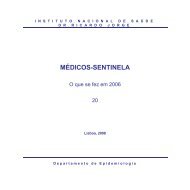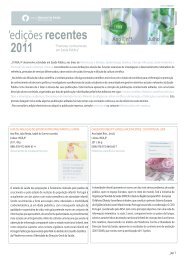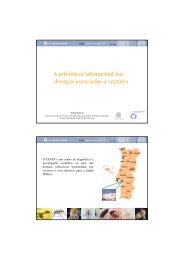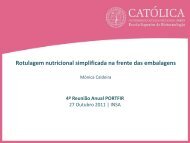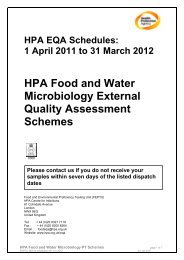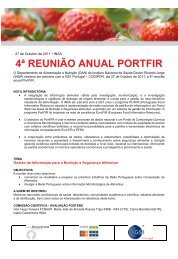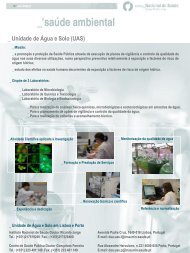European Society of Mycobacteriology - Instituto Nacional de Saúde ...
European Society of Mycobacteriology - Instituto Nacional de Saúde ...
European Society of Mycobacteriology - Instituto Nacional de Saúde ...
Create successful ePaper yourself
Turn your PDF publications into a flip-book with our unique Google optimized e-Paper software.
PP-60<br />
ISOLATION AND FREQUENCY OF Mycobacterium sp IN A<br />
GENERAL HOSPITAL DURING A 9-YEAR PERIOD<br />
Portugal C.; Sancho L.; Dias A.; Tancredo L.; Silva M.; Sardinha T.; Sousa Germano<br />
Laboratory <strong>of</strong> Microbiology, Department <strong>of</strong> Clinical Pathology<br />
Hospital Fernando Fonseca – Amadora, Portugal<br />
mclaraportugal@hotmail.com<br />
Tuberculosis remains a major public heath problem in Portugal with an inci<strong>de</strong>nce rate <strong>of</strong> 25,3/100.000 inhabitants in 2008,<br />
being the majority <strong>of</strong> the cases in the surroundings <strong>of</strong> the two major cities (Lisbon and Oporto).<br />
Our Hospital is located in the Lisbon’s surroundings and covers a population <strong>of</strong> 750.000 inhabitants most <strong>of</strong> them with<br />
poor socioeconomic level and immigrants from Africa and East Countries.<br />
Purpose<br />
The aim <strong>of</strong> this study was to investigate the isolation frequency <strong>of</strong> Mycobacterium sp. in a general Hospital in Amadora,<br />
Portugal, during a 9-year period (2000-2008).<br />
Methods<br />
A total <strong>of</strong> 19.417 clinical specimens (15.159 pulmonary and 4.261 extra pulmonary), collected from 9.525 patients, were<br />
cultured for mycobateria. All specimens were processed by the NaCl-NaOH method as recommen<strong>de</strong>d by CDC, stained<br />
by Ziehl-Neelsen, cultured on Lowenstein-Jensen and liquid medium MGIT. I<strong>de</strong>ntification was ma<strong>de</strong> with the technology<br />
Genotype MTBDR plus (HAIN-Lifecience- Germany).<br />
Results<br />
Of the 19.417 cultured specimens for mycobateria, 2751 (14,2%) were positive by cultural methods.<br />
The positive rates by clinical specimen were: 17% (279/1684) in respiratory specimens and 6% (26/476) in extra pulmonary<br />
tuberculosis; 21% (5/23) in pus, 11% (2/14) in biological liquids, 8% (5/66) in biopsy, 6% (7/112) in blood, 5% (1/22)<br />
in ascitics fluid, 4% (1/22) in mieloculture, and 3% in urine (4/133) and cerebrospinal fluid (2/84).<br />
In 9525 suspected TB patients, 1094 were effective tuberculosis cases (122 TB cases/year average, 97 cases in 2008). The<br />
inci<strong>de</strong>nce rate by patient was 11,5%.<br />
In comparison with the positive results <strong>of</strong> the culture, Ziehl-Neelsen stain was positive in 39% <strong>of</strong> the samples (47% <strong>of</strong><br />
the patients).<br />
96% (1029) <strong>of</strong> mycobateria isolated were Mycobacterium tuberculosis Complex, 2% (20) M.avium, 2% (20) other species<br />
(M.chelonae, M.intracellulare, M.alsiensis / malmoense / szulgai, M.scr<strong>of</strong>ulaceum, M.lentiflavum).<br />
Conclusion<br />
In spite <strong>of</strong> the increase <strong>of</strong> TB suspected patients (+11,3%), the number <strong>of</strong> effective tuberculosis cases have <strong>de</strong>creased<br />
(-7,8%) for a 9-year period, which is comparable to 2008 national data (-7,2%) in the last <strong>de</strong>ca<strong>de</strong>.<br />
Tuberculosis is a major problem in this area with an recovery rate <strong>of</strong> 14,2% in the clinical specimens that we receive and<br />
in 11,5% <strong>of</strong> the patients, most <strong>of</strong> them with Mycobacterium tuberculosis Complex (96%).<br />
We have one positive patient every 3 days.<br />
In attempt to minimize the impact <strong>of</strong> this disease, that <strong>de</strong>pend on a large number <strong>of</strong> factors, we know that the laboratory<br />
plays an important role in making a <strong>de</strong>finitive diagnosis in a short time period (ASAP). We also know that is important a<br />
close relation between the microbiology laboratory and the hospital doctors and also with the centre that follows the<br />
patients in the community (CDP). This is our policy.<br />
132 ESM 2009



